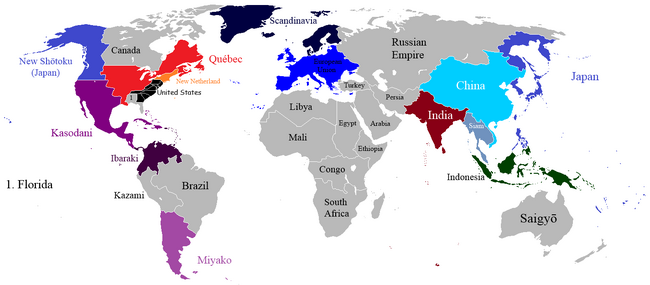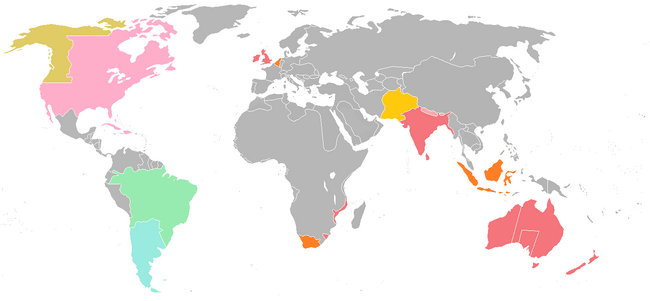Map Contest 8 (Open): Pink Stars Are Falling In Lines[]
Challenge: Create a scenario where the United States still forms, but it is somehow skewed. Take this as you may. Surprise me.
Time Frame: Two weeks, October 27 - November 9
Japan's Desire Drive -Kogasa[]
In this timeline, the Kamakura Shogunate manages to defeat the Imperial forces in the Genkō War. With this, the Kamakura Shogunate stays in power, and begins to strengthen. Soon, Japan begins expanding into Hokkaido, Karafuto (Sakhalin), and parts of Siberia. Japan also discovers the New World in 1400, and begins colonising most of it. Japan also colonised Australia and New Zealand as well. Once Spain reached the New World they encountered the Japanese, and soon a trade agreement was signed. The Spanish go on to colonise Florida and Guyana while Portugal goes on to colonise Brazil.
The British and Netherlands also colonise parts of Vinland (North America), particularly the East Coast. The Dutch victories in the Anglo-Dutch Wars allows them to keep New Netherland. Meanwhile the French were able to hold onto Louisiana and Québec, and made them Dominions later on.
Soon sometime in the 1770s, the British East Coast rebel and form the United States. Later in 1793, New Netherland declares independence from the Netherlands. These two nations would have tensions with each other until 1815. In the 1820s, the Japanese colonies in North and South Vinland began to revolt and formed their own nations. One of them was Miyako in South Vinland, which was named after the Miyako Island.
By the 1900s, North and South Vinland became mostly peaceful. The United States pursued an isolationist policy, and remained neutral since the beginning of this policy. Meanwhile, Québec becomes the superpower of North Vinland and becomes involved in the international stage, alongside Brazil and Miyako. There was only one World War, which took place from 1914 to 1923.
Later, in the 1970s, the European Union was formed. The nations of Europe (except Scandinavia and Russia) then went on to merge into one large nation, in 2008.
The Superpowers in this World are Québec, Miyako, Brazil, China and Japan. The European Union and India are new potential Superpowers.
The main characters of the Touhou Project are Seiga Kaku and Satori Komeiji.
Discussion
- This is one of your more unorthodox ones. Although if Europe were anything like OTL - the day it united, it would be an instant superpower LOL. :D
 Imp (Say Hi?!) 16:28, October 29, 2013 (UTC)
Imp (Say Hi?!) 16:28, October 29, 2013 (UTC)
Comments
Here They Come! ~Guns[]
(map coming soon)
In this TL, the Vikings follow up on the exploits of Leif Ericsson, sending dozens of ships to colonize Vinland. Rumours spread about the newly discovered land, and soon the English follow them.
(more to follow)
Discussion
Comments
The British are coming ... (Local)[]
John Cabot mentions his discovery of a landmass to the English Government and they run with it. They colonize North America, down to about the Utah southern border, and along that line. This caused the English to be able to swiftly unite the kingdoms. When the Spanish found South America, a few decades later, they found it a lot more difficult to colonise. The British had traded with the tribes. They had taken gold in exchange for guns, metal and horses. They also exposed the tribes to diseases. When the Spanish landed, they were gunned down. The diseases they brought had no significant affect on the tribesmen, and they found themselves facing men with guns and horses. The Spanish, without American colonies to sustain them, fell from Grace. Meanwhile, the British, enjoying the feeling of power they got with colonies, began to colonise Asia and Africa. The colonisation by Britain caused the French to join in. The colonial arms race reached a climax in 1624. The French invaded a British colony in Africa, and Britain retaliated. As the war grew, taxes grew with it. The North American colonies, sick of the war and of the taxes, declared independence. The Anglo-French war ended shortly after this, and the British finally turned their attention to the rebels. Although the rebels won, the victory was hollow. The British retained most of the colonies, and the 'United States of America' consisted only of a small part of OTL Nevada, and some of Colorado. The British allowed them to live, and protected the little nation from other powers, purely because they did not want them to gain a foothold. They also knew that if they invaded the USA, the 'rebel elements' would disperse throughout the colony, and wreak havoc. This way was safer. The world remained at a status quo until 1900.
Discussion
Comments
It Was Not To Be ~Imp[]
The British go on to establish their colonies in America like OTL. However, when the Americans rebel, Britain is not willing to give up easily and allocates more troops to the effort. The German General who helped organise the American soldiers also arrives a year or two late and this allows for a more bloody and longer War of Independence. Union falls apart. British invade again. Union is remade and stays together this time. Becomes aggressive and powerful on its own continent. Basically.
French moved and no OTL Quebecois Independence Movement. Every town has a Frenchtown.
Discussion
Comments
I'M A CANADIAN ~Oct[]
This is my first entry so the explanation is not going to be long. But it is basically where the British win the war of 1812 and then the Canadians declare independence in 1840. Wanting to avoid a long war the British give in with the Treaty of Madrid.
The Treaty of Madrid states that Canada will become independent but will keep a bit of British influence. After 1840 Canada falls in the United States place in history, Spanish-Canadian war, WWI, WWII, Superpower.
IF YoU WANT MORE ASK
Discussion
Comments
15 Bright Stars in the Sky[]
In this timeline, France and her allies win the Seven Years' War. As a result of this, the British American lands are given independence under the leadership of Benjamin Franklin. Under his guidance, the United States of North America becomes a center of the Enlightenment. States have more rights, et cetera. America goes Rambo on expansion, invading most European lands in the New World by 1800. When Napoleon comes about, America does not interfere until it sees an opportunity to expand its reach farther.
Basically Napoleon wins and blah blah blah I'm sitting out the next contest blah blah blah.
1812 Finale ~Callumthered[]
In a world where the USA lost the Second Anglo-American War, 1812, instead of being the overture to American dominance on the world stage, became its finale. (I hope you all get the reference).
During the War of 1812 OTL, the people of New England (many of whom were Loyalists or descended from Loyalists, and a large number of whom depended on trade with Britain) were angry and distressed at the war and resultant British blockade of trade. There was a genuine movement amongst New Englanders to declare independence from the Union which, through its continuing with the war, was slowly strangling New England's economy. The Point of Diversion for this timeline involves New England seceding from the United States in 1814. The new republic sought a speedy suspension of hostilities with Britain. With New England troops pulling out of the war, the American positions collapsed. British forces swept through New York and the United States was forced to sign the disastrous "Treaty of Washington". The treaty ceded all of New York and the Louisiana Purchase to Britain.
In the Congress of Vienna, Talleyrand was able to manipulate and negotiate his way to France receiving a territory centred on New Orleans (approx the OTL State of Louisiana).
A weaker central government resulted in the Carolinas and Georgia seceding from the union in the 1850s over the slave issue (slavery was only abolished in those states in the late 1880s).
The British settled the "Missippi Colony" extensively, and it was a founding member of the Confederation of North America, which was relabelled a "realm" in 1901. Today, the RNA is, along with Mexico, the biggest power in North America.
Without a strong USA trying to uphold the Monroe Doctrine, (and with a big base for troops right next door in Louisiana) Napoleon III was able to invest more troops into keeping the Second Mexican Empire afloat. His success (relative to OTL) in foreign policy meant that Napoleon III did not feel the need to gain popularty in a war with the North German Confederation. As a result, the southern German states (Bavaria, Wurrtemberg and Baden) remain independent monarchies to this day.
Without the USA to send Commodore Perry, the "task" of opening Japan up to foreigners fell to Britain. Britain pursued the same policy as it had with China, trying to get the Shoguns to sign extremely unfair treaties. When the Shoguns refused, the British backed the Imperial faction (assisted by the Satsuma domain and the Chosu domain) in the TTL Boshin War. France, seeing an opportunity to gain influence in the far East, backed the Shogun's forces. The Boshin war was much more of a proxy war between the two powers than OTL. In the end, Franco-Shogunate forces were pushed to Hokkaido, where a French-backed "Edo Republic" was formed. The Satcho Alliace (Satsuma and Chosu Domains), seeing the way the British were forcing unfair treaties on the new Imperial government, seceded with a bit of help from their old allies the Dutch.
Australia went pretty much like OTL. However, without a good example of federalism in the USA, Queensland and Western Australia did not join the Australasian federation in 1901. Interestingly, New Zealand and Fiji did.
In Africa, a more confident France was able to reach Fashoda first, and complete their Atlantic to Red Sea Empire in Africa. This peeved the British to such an extnt that Anglo-French relations could never be healed. In the leadup to the turn of the century, France, Austria, Russia, Bulgaria and the Southern German states formed one alliance, while Britain, the North German Confederation, Italy and the ailing ottoman Empire formed the other alliance.
The spark for World War came during the Balkan War of 1912, when Bulgaria marched on Constantinople. The British, unwilling to see their ally lose control over the Dardanelles, declared war on Bulgaria, which set off the chain of alliances. There were Western, Eastern, Dardanelles and African fronts like the OTL First World War, but added to that, there was a North American front where the French-backed Mexican Empire clashed with the North American Realm. The war ended in 1916 when the North German Confederation underwent a revolution, which sent the King of Prussia packing for German East Africa (which became the Kingdom of Tanganyika). Austria-Hungary soon disintegrated, and it was only through a Franco-Bavarian intervention that a rump Austrian Empire was saved. Gallicia, Hungary and Czechoslovakia became Communist, and they were joined by Russia when the post-war depression proved too much for the autocratic regime. The Tsars fled to Alaska (which was still Russian - there was no USA to sell it to) where they lay in wait.
The remaining monarchies/democracies reluctantly put aside their differences and entered a cold war with the Communists. The Chinese Civil war resulted in a Soviet-backed PRC being formed (which, without American backing of the KMT, included Taiwan). Without a strong Japan, the Pacific War never took place.
Communism in Europe fell in the 1990s, but remained in Galicia. The Tsars returned from Alaska and re-established the monarchy on mainland Russia. The French and British Commonwealths are generally regarded to be the major world powers, followed by a rising China and Russia.
That's pretty much all.





